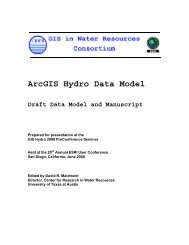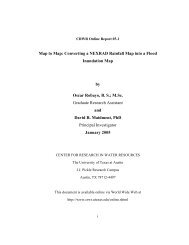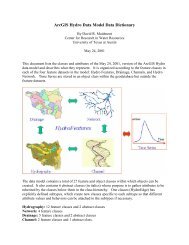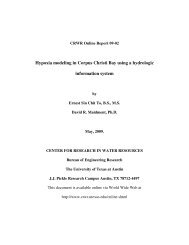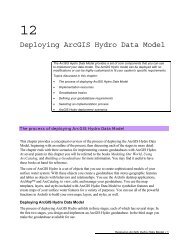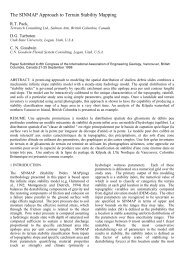View the Whole Report - Center for Research in Water Resources ...
View the Whole Report - Center for Research in Water Resources ...
View the Whole Report - Center for Research in Water Resources ...
Create successful ePaper yourself
Turn your PDF publications into a flip-book with our unique Google optimized e-Paper software.
A Hach Model 2100A Turbidimeter was used to estimate turbidity. The measured<br />
turbidity of a distilled water sample was used as a blank <strong>for</strong> sample analysis. Turbidity<br />
read<strong>in</strong>gs were obta<strong>in</strong>ed from <strong>the</strong> appropriate primary and secondary scales. Values are<br />
reported <strong>in</strong> nephelometric turbidity units (NTU's). Duplicate analyses were conducted <strong>for</strong><br />
every tenth sample. The average value was reported <strong>for</strong> duplicate analyses.<br />
Dilution was used <strong>for</strong> highly turbid samples to br<strong>in</strong>g <strong>the</strong> sample <strong>in</strong>to <strong>the</strong><br />
<strong>in</strong>strument range. The measured turbidity was multiplied by <strong>the</strong> dilution factor to obta<strong>in</strong><br />
corrected turbidity values <strong>for</strong> <strong>the</strong> orig<strong>in</strong>al sample.<br />
Suspended Particle Size Classification<br />
Particle size <strong>in</strong>fluences <strong>the</strong> primary functional mechanisms <strong>for</strong> control. There<strong>for</strong>e,<br />
some <strong>in</strong>sight regard<strong>in</strong>g particle size of <strong>the</strong> suspended solids is required to successfully<br />
evaluate <strong>the</strong> per<strong>for</strong>mance of <strong>the</strong> system.<br />
A method <strong>for</strong> approximat<strong>in</strong>g <strong>the</strong> percentage of silt and clay particles and <strong>the</strong><br />
percentage of particles larger than silts was developed. Each sample was evaluated <strong>for</strong><br />
TSS as collected or as composited accord<strong>in</strong>g to <strong>the</strong> procedure described previously.<br />
Subsequently, <strong>the</strong> sample was reanalyzed <strong>for</strong> TSS after pass<strong>in</strong>g <strong>the</strong> sample through a U.S.<br />
Standard number 230 sieve with nom<strong>in</strong>al open<strong>in</strong>gs of 63 mm. The <strong>for</strong>mula <strong>for</strong><br />
percentage of silts and clays:<br />
TSS B - TSS A<br />
% = 100 - ( x 100)<br />
TSS B<br />
where: TSS B = TSS be<strong>for</strong>e #230 siev<strong>in</strong>g (mg/L) and<br />
TSS A = TSS after #230 siev<strong>in</strong>g (mg/L).<br />
In reality, this estimate is conservative. AASHTO classifies silts and clays as those<br />
particles smaller than 75 mm. Wet siev<strong>in</strong>g results <strong>in</strong> some particle adherence to <strong>the</strong><br />
screen.<br />
98




